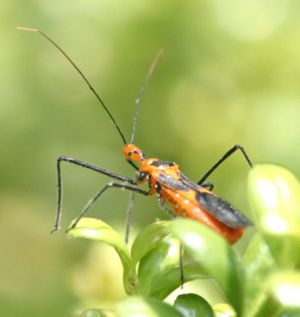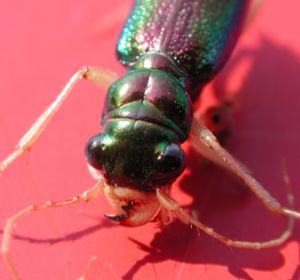Insect
- The content on this page originated on Wikipedia and is yet to be significantly improved. Contributors are invited to replace and add material to make this an original article.
| Insects Fossil range: Carboniferous - Recent | ||||||||
|---|---|---|---|---|---|---|---|---|
| Scientific classification | ||||||||
| ||||||||
| Subclasses | ||||||||
|
Insects (Class Insecta) are a major group of arthropods and the most diverse group of animals on the earth, with over a million described species [1] — about three quarters of all animal species.
Estimates of the total number of current species, including those not yet known to science, range from two million to fifty million, with newer studies favoring a lower figure of about six to ten million.
The study of insects (from Latin insectus, meaning "cut into sections") is called entomology, from the Greek εντομος, also meaning "cut into sections." This is from the three body sections that characterize most insects: head, thorax and abdomen.


Identification
Insects belong to the subphylum Hexapoda, from the Latin meaning "six feet," meaning they have three pairs of legs. The vast majority of insects belong to the subclass Pterygota, meaning they have one or two pairs of wings arising from the thorax. However, some insects are wingless. All insects have one pair of sensory antennae arising from the head. Proturans, which were once considered insects, have no antennae; however, today they are considered members of a separate class, Entognatha. All insects have a segmented external skeleton, composed mostly of chitin. Insects generally have compound eyes.
Other terrestrial arthropods, such as pillbugs, centipedes, scorpions and spiders, are sometimes confused with insects as they share (as do all arthropods) a jointed exoskeleton. However, their features in fact differ significantly; most noticeably they do not have the six legs characteristic of adult insects.
Habitat
Insects may be found in nearly all environments on the planet. They are noticeably absent from the ocean, where crustaceans tend to predominate instead. Of the few species of insects considered to be marine, no adult forms live in the seawater; rather, they are found skimming across its surface. Most species' with ocean dwelling larvae grow in tidal pools or otherwise close to the shore.[2]
Significance
Many insects are considered pests by humans. Some species spread disease and consume crops. However, most insects are considered (-a value judgement from a human point of view) beneficial to the environment and to humans. Less than one per cent of all insects are pests, and only a few hundred species are serious pests. [3] Likewise some insects function in mixed roles, for example species of moths that may be pests in the larval stage of life, but pollinators in the adult stage.
Role as pests
Insects commonly regarded as pests include those that are parasitic such as mosquitoes, lice, and bedbugs. Pest insects also may transmit diseases. (Mosquitoes are vectors of malaria, dengue, encephalitis, yellow fever and west Nile virus among others. Flies may carry diarrhea, typhoid fever, dysentery, tuberculosis, and shigellosis as well as many other diseases. Kissing bugs) are vectors of Chagas disease. Other pest insects may damage structures - (termites, carpenter ants, powderpost beetles).
Agricultural crops or stored foods may be damaged or destroyed by insects such as (locusts, plum Curculio, aphids, leaf miners, Japanese beetles, tent caterpillars, gypsy moths, and weevils). It is impossible to entirely eliminate pest insects from the human food chain; insects already are present in many foods, especially grains. Food laws in many countries do not prohibit insect parts in food, but rather limit the quantity.
Many entomologists are involved in various forms of pest control, often using insecticides, but more and more relying on methods of biocontrol. Human attempts to control pest insects by insecticides can backfire, however, because important but unrecognized insects already helping to control pest populations are also killed by the poison, leading eventually to population explosions of the pest species. [4]
Role as beneficial
Pollination of flowering plants is a major role of bees, syrphid flies, butterflies, wasps, beetles, and ants. Pollination is a trade between plants that need sexual reproduction, and pollinators that receive nutritional rewards of nectar and pollen.
A serious environmental problem today is the decline of populations of pollinator insects, and a number of species of insects are now cultured primarily for pollination management in order to have sufficient pollinators in the field, orchard or greenhouse at bloom time. Some species of plants are threatened primarily because of the loss of their pollinators.
Insects also produce useful substances such as honey, wax, lacquer and silk. Honey bees have been cultured by humans for thousands of years for honey, although contracting for crop pollination is becoming more significant for beekeepers. The silkworm has greatly affected human history, as silk-driven trade established relationships between China and the rest of the world. Fly larvae (maggots) were formerly used to treat wounds to prevent or stop gangrene, as they would only consume dead flesh. This treatment is finding modern usage in some hospitals. Adult insects such as crickets, and insect larvae of various kinds are also commonly used as fishing bait.
In some parts of the world, insects are used for human food ("entomophagy"), while being a taboo in other places. [5] There are proponents of developing this use to provide a major source of protein in human nutrition. According to cultural materialist anthropologist Marvin Harris, the eating of insects is taboo in cultures that have protein sources that require less work, like farm birds or cattle.
Many insects, especially beetles, are scavengers, feeding on dead animals and fallen trees, recycling the biological materials into forms found useful by other organisms, and insects are responsible for much of the process by which topsoil is created.
Although mostly unnoticed by most humans, the most useful of all insects are insectivores, those that feed on other insects. Many insects, such as grasshoppers, can potentially reproduce so quickly that they could literally bury the earth in a single season. However, there are hundreds of other insect species that feed on grasshopper eggs, and some that feed on grasshopper adults. This role in ecology is usually assumed to be primarily one of birds, but insects, though less glamorous, are much more significant. For any pest insect one can name, there is a species of wasp that is either a parasitoid or predator upon that pest, and plays a significant role in controlling it.
Historical significance
Insects feature most predominantly in ancient Egyptian religion, adored beetles and represented them as scarabeums. Ancient Egyptians also practiced apiculture, and frequently would bury Pharaohs with honey.
References
- ↑ url=http://www.nysaes.cornell.edu/ent/biocontrol/info/primer.html
- ↑ url=http://cgi.unk.edu/hoback/marineinsects/marineinsects.htm
- ↑ url=http://www.nysaes.cornell.edu/ent/biocontrol/info/primer.html
- ↑ url=http://cipm.ncsu.edu/ent/biocontrol/qanda.htm
- ↑ url=http://www.ag.auburn.edu/aaes/webpress/1999/entomophagy.htm
